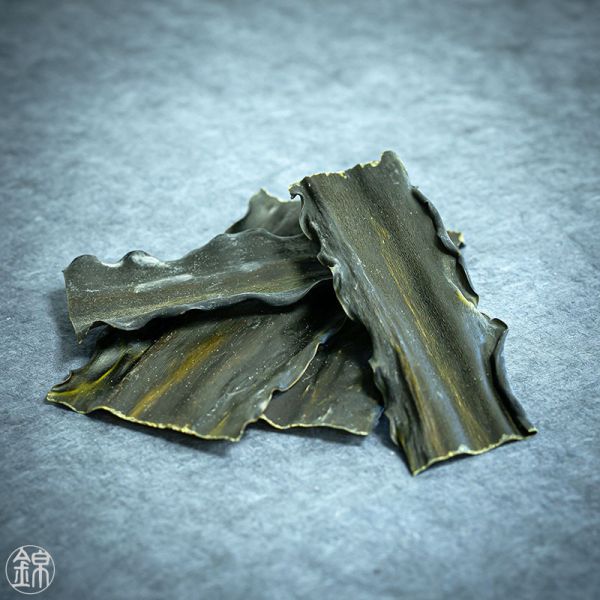Kura-gakoi cellar-aged kombu from Rishiri and Rebun islands
Kura-gakoi cellar-aged kombu from Rishiri and Rebun islands
 Kombu seaweed for making high quality dashi
Kombu seaweed for making high quality dashi
Kombu proposed here comes from Rishiri and Rebun islands, located north of Hokkaido Island, renowned for their wild kombu, the rarest and most qualitative in the world.
Only a few privileged people have access to them and Okui Kaiseido, our artisan, is recognized in Japan as the absolute reference.
All Kombu from Okui Kaiseido are preserved and aged in a special ageing cellar, at controlled temperature and humidity, using the Kura-gakoi technique, as for the preservation of wine.
This method reduces smell of the sea and unpleasant taste of Kombu flesh and brings out true UMAMI, offering subtlety and elegance to tasting.
Cellar and storage boxes are made of Japanese cedar wood. Kura-gakoi process enhances kombu, developing its flavors and concentrating umami, resulting in an exceptional dashi.
Our recommendation for making your own dashi :
Soak kombu for 24 hours in cold water to soften it.
First dashi, called Ichiban dashi, is an almost pure umami broth. Synergy between kombu and katsuobushi produces and enhances clear umami taste.
Made from the finest ingredients, it has a rich golden color and no astringency as is usually the case with dashi made from other ingredients.
Clear, subtle aroma of ichiban dashi is ideal for making clear broths. Ichiban dashi itself is delicious, but it allows you to bring out flavor of other foods without paying too much attention to other ingredients.
 For a good dashi :
For a good dashi :
♦ 1800 ml of fresh water
♦ 30-40g of Rishiri kombu
♦ 50g of katsuobushi (blood line should be removed)
1. Put the water and kombu in a large pot and heat over low heat
2. Slowly increase temperature to 60°C and simmer for 1 hour at this temperature to bring out maximum umami of the kombu.
3. Remove kombu and increase temperature to 85°C over high heat. When temperature reaches 85°C, add katsuobushi flakes so that they soak up water completely.
4. After waiting about 10 seconds, strain liquid through a fine-mesh cloth and let it drain naturally without squeezing katsuobushi flakes.
 Kombu contains glutamic acid, a type of amino acid with UMAMI. Glutamic acid umami can be enhanced by aging Kombu and it also increases synergistically when combined with inosine acid included in dried bonito. Kombu is also rich in dietary fiber, calcium and iodine. Its alkaline nature helps maintain a balance with acidic foods such as meat and fish.
Kombu contains glutamic acid, a type of amino acid with UMAMI. Glutamic acid umami can be enhanced by aging Kombu and it also increases synergistically when combined with inosine acid included in dried bonito. Kombu is also rich in dietary fiber, calcium and iodine. Its alkaline nature helps maintain a balance with acidic foods such as meat and fish.
| Typ | Kombu |
|---|---|
| Gewicht | 30 g net |
| Herkunft | Rishiri and Rebun, Hokkaido, Japan |
| Verpackung | sachet |
| Ingredients | 100% Kombu (Saccharina ochotensis) from Rishiri and Rebun islands |
| Storage | away from direct light in a dry and cool place |
| Recommanded use | Cooking |
| Grösse | 30g |


Anmelden